Permaculture farm in Dunmanway County Cork hosts summer language students from Bilbao
It’s all happening around Dunmanway County Cork these days. Since I began my professional permaculture design practice, the area between Drimoleague and Dunmanway County Cork has shown to be a consistent hot-spot for permaculture projects. A few years ago I worked on a farm permaculture design for the Kingston family near Coolkellure, now known as Nowen Rock Regenerative Natural Habitats. Recently John Kingston and I have been collaborating on the build of another local permaculture project in that area.
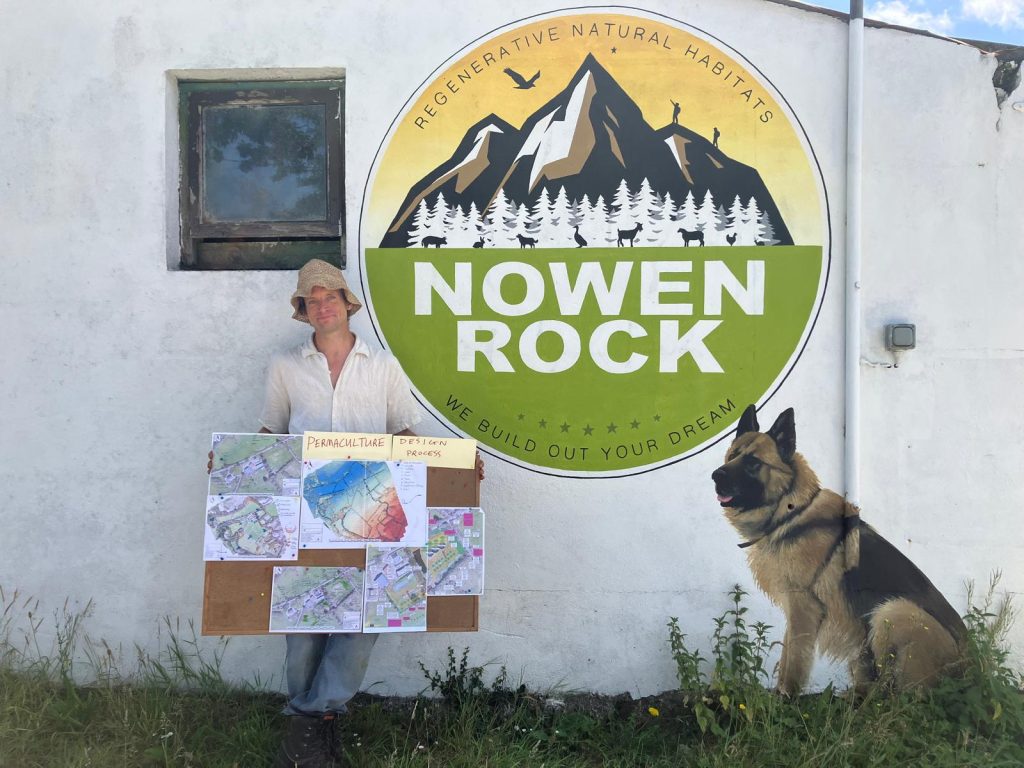
Teaching Children Permaculture
John asked me if I spoke Spanish and if I would do a day teaching permaculture for a group of English language students coming from Bilbao to visit his farm. Of course I was delighted to get involved and do more teaching. It was quite a new challenge however as I had not taught children permaculture before, nor a group with another first (and second!) language.
Permaculture in Spain
At one time I had quite fluent Spanish, as early on my permaculture journey I lived and worked in Spain for about a year, including some volunteering on permaculture farms on Ibiza and on the mainland near Lleida, in Catalonia. In fact the first permaculture book I ever read was a Spanish translation of Bill Mollison and David Holmgren’s Permaculture 1 on that farm on Ibiza.
These were English language students however, so I would teach in English but my Spanish proficiency was going to be helpful. More importantly the students weren’t permaculture students per se, so while preparing the workshop I thought about what aspect of permaculture would be most relevant and interesting to them. I quickly concluded that something related to climate differences between their home in Bilbao and here in Ireland would be relevant and interesting. Nearly everyone talks about and notices the weather, and climate is the most important influence on permaculture and keyline design.
Permaculture Game #1: Guess your Climate
Before the workshop I prepared a series of graphs comparing climate averages for Dunmanway and Bilbao, displaying the monthly figures for temperature, rainfall, sunshine and average wind speed. I had these ready on a display board, hidden for now. What the group got was charts with the averages for Dunmanway and Madrid, and the game was to guess the Bilbao averages.
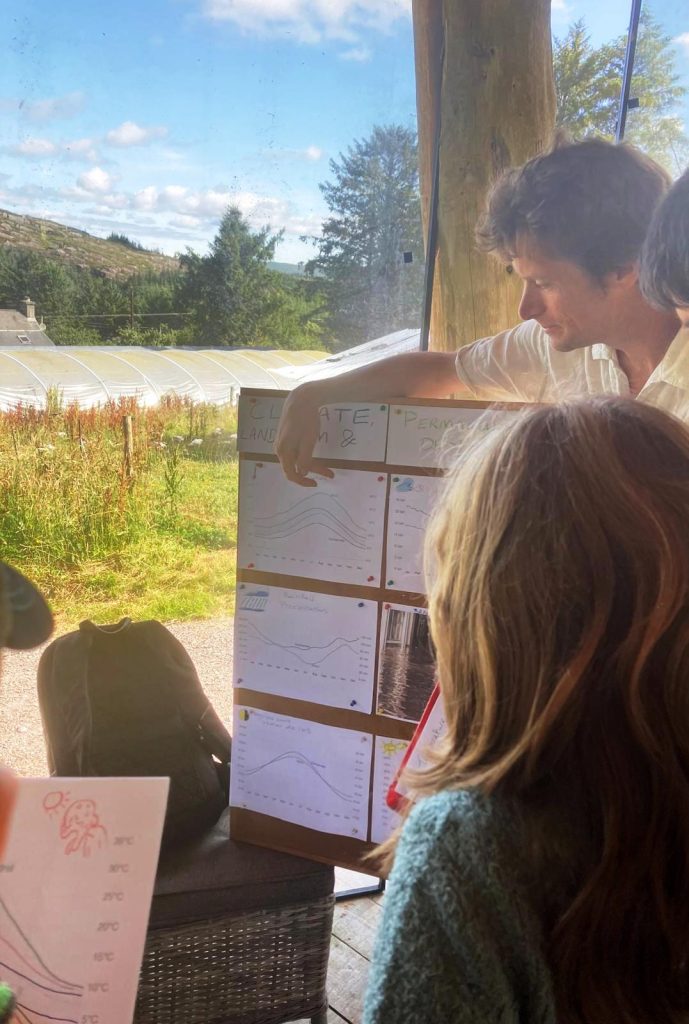
Surprise climate guesses – more winter sun in Dunmanway than Bilbao
It was amazing how accurate some of the guesses were, but there were some surprises. For example, all of the groups guessed that Bilbao had some months of LESS winter sun than Dunmanway, Ireland! I partly guessed that there would be some such anomaly, as they would be used to climate comparisons with the rest of Spain, where Bilbao will generally be one of the relatively wetter and less sunny areas. (They had been enjoying some wonderful summer sun in Ireland too it must be said!)
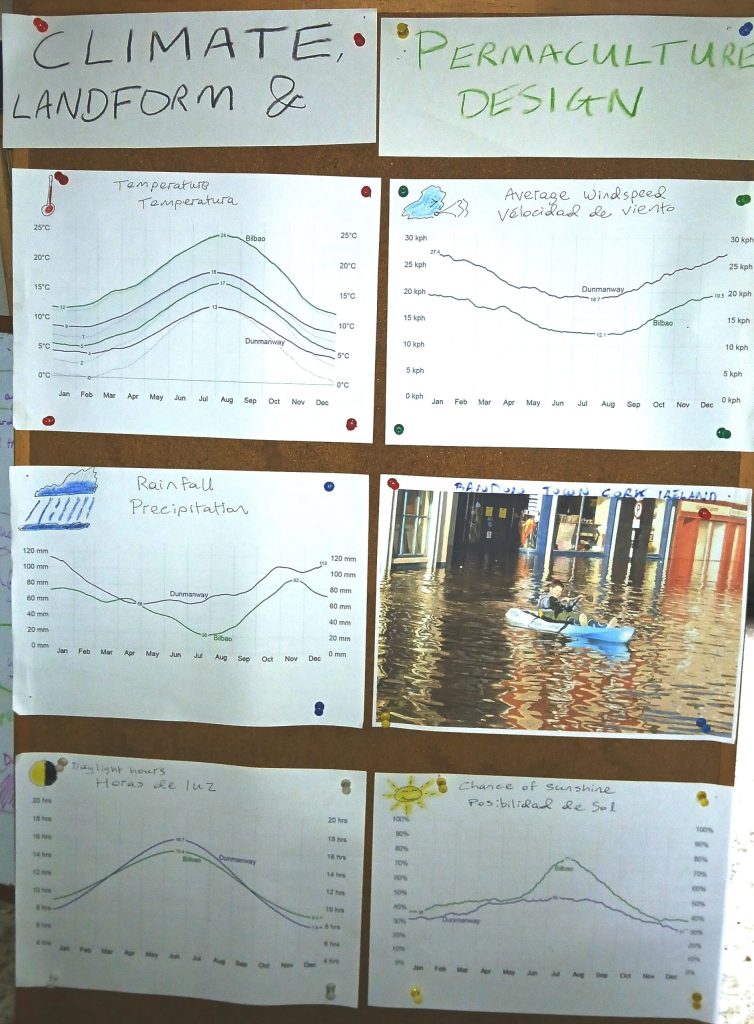
Bilbao – excess winter rain and summer drought
All three groups correctly estimated that there is a big reduction in rainfall and increase in sunshine in Bilbao during the summer months, compared to Ireland where it is relatively rainy during the summer. This was the topic of discussion that I wanted to develop. I asked if there is enough water in Spain in the summer and what measures can be taken to supply water during the summer months? The logical answer (which they easily guessed) was storage of the winter excess, and so we had a route into keyline design, which is the forerunner of permaculture design.
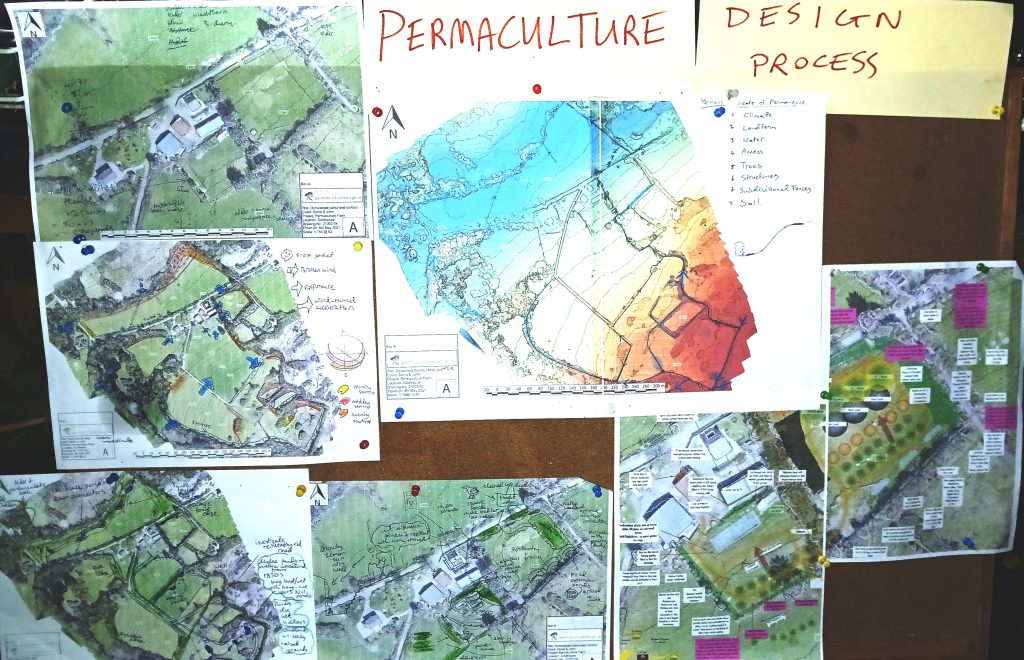
Designing out flood and drought – are floods preventable?
We were also conscious of the recent flooding tragedies in Spain, Texas and elsewhere in the world. In general these events are deemed natural disasters and unpreventable. But now, high up in the headwaters of the Bandon river valley, itself often in flood further downstream at Bandon town, we could see that landscape design has a vital role to play in controlling water flow downstream, in ameliorating both flood and drought conditions.
Permaculture Game #2: Twenty-four hour human sundial
The next game was creating a human twenty-four hour sun-clock out in the open with a one participant embodying the sun’s transit across the sky during the day and the year, and another enacting the prevailing wind. The objective was to learn how to estimate the time of day if the sun can be seen and one’s orientation known, or to be able to estimate one’s orientation if the time and position of the sun is known. There were some interesting questions regarding applicability in the southern hemisphere and near the equator.
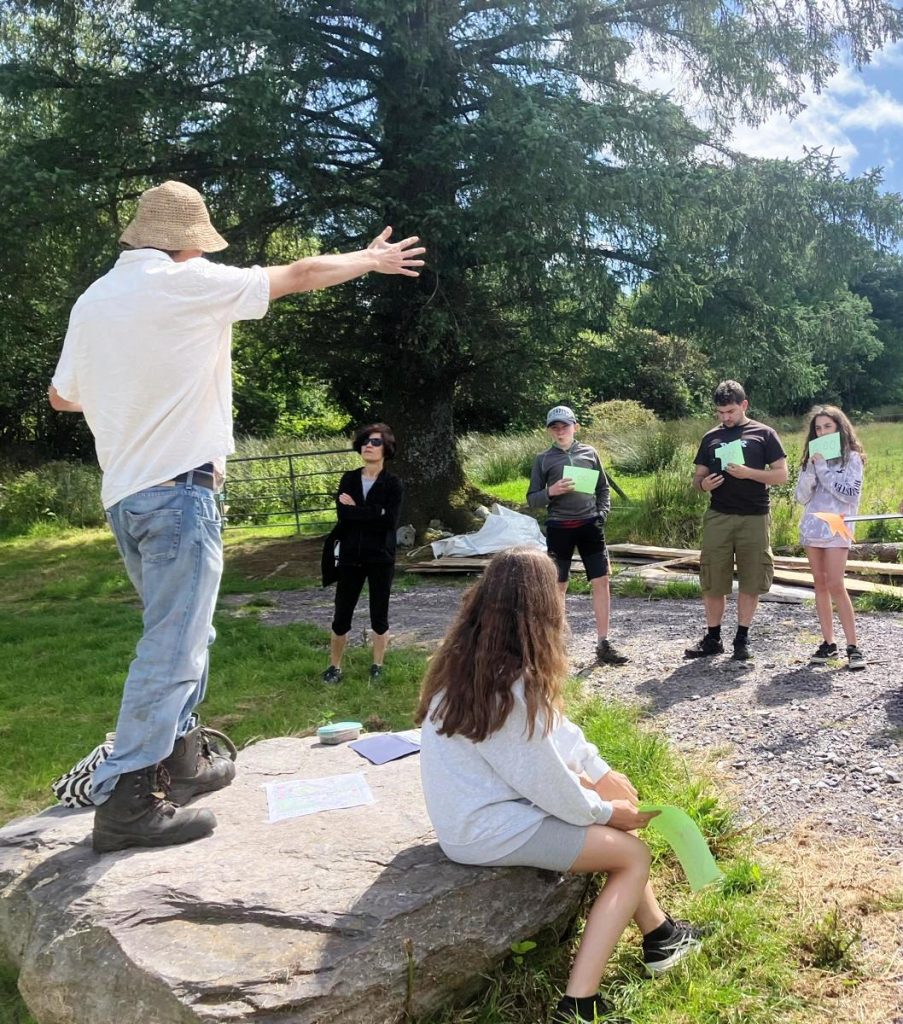
The relevance of this exercise is of course to get a grounding and feeling for the impact of the elements on a design site and on how the interaction of wind, sun and rain with the landform largely create the different micro-climates that exist across a site. Successfully identifying micro-climates existing on a site is a huge clue as to how to proceed with design. When I design I place elements appropriately to benefit from the microclimates or indeed to ameliorate the conditions, as in the case with positioning tree and shrub windbreaks and shelter-belts.

Soil Tests, Indicator Species and Identifying Pond Sites in the Landscape
For the rest of the workshop we walked around the farm identifying potential water storage areas, looking at a windbreak that had been planted according to the design and digging test holes to look at the soil and subsoil. This proved to be one of the most interesting for the group, maybe due to the active digging and tactile nature of the soil. It was an afterthought to include it but may have been the best part of the day for us.
Later that day on a walk up to the top of the farm, the children were identifying rushes (Juncus juncus) in flat wet areas and commenting that it could be a good pond site. Teaching children permaculture is easier than I expected!
Thanks to Miren who runs the language school in Bilbao who organised the trip, and the wonderful tutors and students who took part in the permaculture workshop.
Two of the group tutors left this feedback:
Paul’s passion and enthusiasm for the intricate and perspective-shifting world of permaculture is inspiring and captivating to learners. He is a wealth of knowledge and resources. Thank you Paul!
David S. Edwards
A very well thought out and hands-on lecture that is very much important for our future.
Julen Ray
Learn Sustainability Skills with Paul
If you have a school, college, university, or community group that want to learn sustainability skills through English, Irish, French or Spanish then get in touch – it’s easy to make it happen! Just like this one, many of the workshops I teach are never listed in the online shop as they come about from individual requests from people who want real sustainability skills in their group/community or workplace.
Get in touch here to make a workshop or lecture enquiry: https://permaculturedesign.ie/contact/
About the Workshop Facilitator
Paul Lynch is an independent sustainability consultant, permaculture designer and orchardist based in West Cork, Ireland. He is co-author of the Mayo Energy Audit 2009 – 2020 and has worked in biomedical R&D engineering in Ireland and in the renewable energy industry in Ireland and Spain. Paul has worked on hundreds of permaculture design and orchard projects across Ireland and designed and built several off-grid renewable energy systems

Paul’s teacher bio: https://www.permaculture.org.uk/user/paul-lynch
All sustainability courses past and present listed here.
Get 10% off Sustainability Workshops
If you would like 10% off off all Ansa Permaculture Design self-hosted workshops then make sure you are a subscriber to my newsletter and always be in the know when new workshops are announced!
Subscribe for 10% off sustainability courses here.
